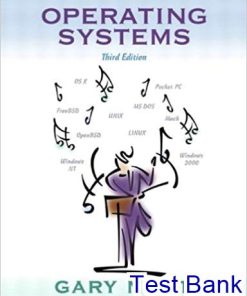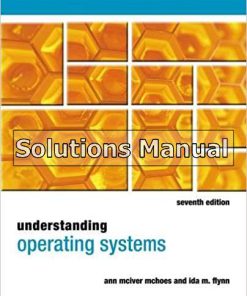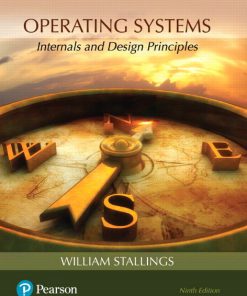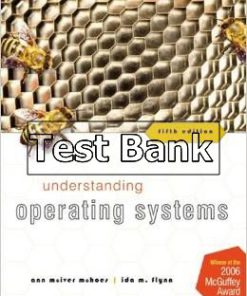$26.50$50.00 (-47%)
In stock
Operating Systems Internals and Design Principles 7th Edition Stallings Test Bank.
You may also like
This is completed downloadable of Operating Systems Internals and Design Principles 7th Edition Stallings Test Bank
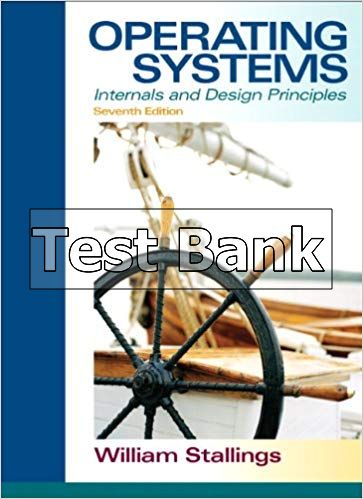
Product Details:
- ISBN-10 : 013230998X
- ISBN-13 : 978-0132309981
- Author: William Stallings
Operating Systems: Internals and Design Principles, 7e is ideal for introductory courses on operating systems.
Operating Systems: Internals and Design Principles provides a comprehensive and unified introduction to operating systems topics. Stallings emphasizes both design issues and fundamental principles in contemporary systems and gives readers a solid understanding of the key structures and mechanisms of operating systems. He discusses design trade-offs and the practical decisions affecting design, performance and security. The book illustrates and reinforces design concepts and ties them to real-world design choices through the use of case studies in UNIX and Windows.
Table of Content:
Chapter 0 Reader’s and Instructor’s Guide 0.1 Outline of the Book
0.2 A Roadmap for Readers and Instructors
0.3 Internet and Web Resources
PART ONE: BACKGROUND
Chapter 1: Computer System Overview 1.1 Basic Elements
1.2 Evolution of the Microprocessor
1.3 Instruction Execution
1.4 Interrupts
1.5 The Memory Hierarchy
1.6 Cache Memory
1.7 Direct Memory Access
1.8 Multiprocessor and Multicore Organization
1.9 Recommended Reading and Web Sites
1.10 Key Terms, Review Questions, and Problems
Appendix 1A Performance Characteristics of Two-Level Memory
Appendix 1B Procedure Control
Chapter 2: Operating System Overview
2.1 Operating System Objectives and Functions
2.2 The Evolution of Operating Systems
2.3 Major Achievements
2.4 Developments Leading to Modern Operating Systems
2.5 Virtual Machines
2.6 OS Design Considerations for Multiprocessor and Multicore
2.7 Microsoft Windows Overview
2.8 Traditional UNIX Systems
2.9 Modern UNIX Systems
2.10 Linux
2.11 Recommended Reading and Web Sites
2.12 Key Terms, Review Questions, and Problems
PART TWO: PROCESSES
Chapter 3: Process Description and Control 3.1 What is a Process?
3.2 Process States
3.3 Process Description
3.4 Process Control
3.5 Execution of the Operating System
3.6 Security Issues
3.7 UNIX SVR4 Process Management
3.8 Summary
3.9 Recommended Reading
3.10 Key Terms, Review Questions, and Problems
Chapter 4: Threads
4.1 Processes and Threads
4.2 Types of Threads
4.3 Multicore and Multithreading
4.4 Windows 7 Thread and SMP Management
4.5 Solaris Thread and SMP Management
4.6 Linux Process and Thread Management
4.7 Mac OS X Grand Central Dispatch
4.8 Summary
4.9 Recommended Reading
4.10 Key Terms, Review Questions, and Problems
Chapter 5: Concurrency: Mutual Exclusion and Synchronization 5.1 Principles of Concurrency
5.2 Mutual Exclusion: Hardware Support
5.3 Semaphores
5.4 Monitors
5.5 Message Passing
5.6 Readers/Writers Problem
5.7 Summary
5.8 Recommended Reading
5.9 Key Terms, Review Questions, and Problems
Chapter 6: Concurrency: Deadlock and Starvation 6.1 Principles of Deadlock
6.2 Deadlock Prevention
6.3 Deadlock Avoidance
6.4 Deadlock Detection
6.5 An Integrated Deadlock Strategy
6.6 Dining Philosophers Problem
6.7 UNIX Concurrency Mechanisms
6.8 Linux Kernel Concurrency Mechanisms
6.9 Solaris Thread Synchronization Primitives
6.10 Windows 7 Concurrency Mechanisms
6.11 Summary
6.12 Recommended Reading
6.13 Key Terms, Review Questions, and Problems
PART THREE: MEMORY
Chapter 7: Memory Management 7.1 Memory Management Requirements
7.2 Memory Partitioning
7.3 Paging
7.4 Segmentation
7.5 Security Issues
7.6 Summary
7.7 Recommended Reading
7.8 Key Terms, Review Questions, and Problems
Appendix 7A Loading and Linking
Chapter 8: Virtual Memory 8.1 Hardware and Control Structures
8.2 Operating System Software
8.3 UNIX and Solaris Memory Management
8.4 Linux Memory Management
8.5 Windows 7 Memory Management
8.6 Summary
8.7 Recommended Reading and Web Sites
8.8 Key Terms, Review Questions, and Problems
PART FOUR: SCHEDULING
Chapter 9: Uniprocessor Scheduling 9.1 Types of Scheduling
9.2 Scheduling Algorithms
9.3 Traditional UNIX Scheduling
9.4 Summary
9.5 Recommended Reading
9.6 Key Terms, Review Questions, and Problems
Appendix 9A Response Time
Appendix 9B Queuing Systems
Chapter 10: Multiprocessor and Real-Time Scheduling 10.1 Multiprocessor Scheduling
10.2 Real-Time Scheduling
10.3 Linux Scheduling
10.4 UNIX FreeBSD Scheduling
10.5 Windows 7 Scheduling
10.6 Summary
10.7 Recommended Reading
10.8 Key Terms, Review Questions, and Problems
PART FIVE: INPUT/OUTPUT AND FILES
Chapter 11: I/O Management and Disk Scheduling 11.1 I/O Devices
11.2 Organization of the I/O Function
11.3 Operating System Design Issues
11.4 I/O Buffering
11.5 Disk Scheduling
11.6 RAID
11.7 Disk Cache
11.8 UNIX FreeBSD I/O
11.9 Linux I/O
11.10 Windows 7 I/O
11.11 Summary
11.12 Recommended Reading
11.13 Key Terms, Review Questions, and Problems
Appendix 11A Disk Storage Devices
Chapter 12: File Management
12.1 Overview
12.2 File Organization and Access
12.3 File Directories
12.4 File Sharing
12.5 Record Blocking
12.6 Secondary Storage Management
12.7 File System Security
12.8 UNIX File Management
12.9 Linux File Management
12.10 Windows 7 File System
12.11 Summary
12.12 Recommended Reading
12.13 Key Terms, Review Questions, and Problems
PART SIX: EMBEDDED SYSTEMS
Chapter 13: Embedded Operating Systems 13.1 Embedded Systems
13.2 Characteristics of Embedded Operating Systems
13.3 eCOS
13.4 TinyOS
13.5 Recommended Reading and Web Sites
13.6 Key Terms, Review Questions, and Problems
PART SEVEN: SECURITY
Chapter 14: Computer Security Threats 14.1 Computer Security Concepts
14.2 Threats, Attacks, and Assets
14.3 Intruders
14.4 Malicious Software Overview
14.5 Viruses, Worms, and Bots
14.6 Rootkits
14.7 Summary
14.8 Recommended Reading
14.9 Key Terms, Review Questions, and Problems
Chapter 15: Computer Security Techniques
15.1 Authentication
15.2 Access Control
15.3 Intrusion Detection
15.4 Malware Defense
15.5 Dealing with Buffer Overflow Attacks
15.6 Windows 7 Security
15.7 Summary
15.8 Recommended Reading
15.9 Key Terms, Review Questions, and Problems
PART EIGHT: DISTRIBUTED SYSTEMS
Chapter 16: Distributed Processing, Client/Server, and Clusters
16.1 Client/Server Computing
16.2 Distributed Message Passing
16.3 Remote Procedure Calls
16.4 Clusters
16.5 Windows 7 Cluster Server
16.6 Sun Cluster
16.7 Beowulf and Linux Clusters
16.8 Summary
16.9 Recommended Reading
16.10 Key Terms, Review Questions, and Problems
APPENDICES
Appendix A: Topics in Concurrency A.1 Mutual Exclusion: Software Approaches
A.2 Race Conditions and Semaphores
A.3 A Barbershop Problem
A.4 Problems
Appendix B: Programming and Operating System Projects B.1 Animations and Animation Projects
B.2 Simulations
B.3 Programming Projects
B.4 Research Projects
B.5 Reading/Report Assignments
B.6 Writing Assignments
B.7 Documentation Projects
B.8 BACI and Nachos
References
Index
ONLINE CHAPTERS AND APPENDICES
Chapter 17: Networking 17.1 The Need for a Protocol Architecture
17.2 The TCP/IP Protocol Architecture
17.3 Sockets
17.4 Linux Networking
17.5 Summary
17.6 Recommended Reading and Web Sites
17.7 Key Terms, Review Questions, and Problems
Appendix 17A The Trivial File Transfer Protocol
Chapter 18: Distributed Process Management 18.1 Process Migration
18.2 Distributed Global States
18.3 Distributed Mutual Exclusion
18.4 Distributed Deadlock
18.5 Summary
18.6 Recommended Reading
18.7 Key Terms, Review Questions, and Problems
Chapter 19: Overview of Probability and Stochastic Processes 19.1 Probability
19.2 Random Variables
19.3 Elementary Concepts of Stochastic Processes
19.4 Recommended Reading and Web Sites
19.5 Key Terms, Review Questions, and Problems
Chapter 20: Queuing Analysis 20.1 How Queues Behave–A Simple Example
20.2 Why Queuing Analysis?
20.3 Queuing Models
20.4 Single-Server Queues
20.5 Multiserver Queues
20.6 Examples
20.7 Queues with Priorities
20.8 Networks of Queues
20.9 Other Queuing Models
20.10 Estimating Model Parameters
20.11 Recommended Reading and Web Sites
20.12 Key Terms, Review Questions, and Problems
Programming Project One: Developing a Shell
Programming Project Two: The HOST Dispatcher Shell
Appendix C: Topics in Computer Organization C.1 Processor Registers
C.2 Instruction Execution
C.3 I/O Communication Techniques
C.4 Hardware Performance Issues and Multicore Organization
Appendix D: Object-Oriented Design
D.1 Motivation
D.2 Object-Oriented Concepts
D.3 Benefits of Object-Oriented Design
D.4 CORBA
D.5 Recommended Reading and Web Sites
Appendix E: Amdahl’s Law
Appendix F: Hash Tables
Appendix G: Response Time
Appendix H: Queuing System Concepts
H.1 The Single-Server Queue
H.2 The Multiserver Queue
H.3 Poisson Arrival Rate
Appendix I: The Complexity of Algorithms
Appendix J: Standards Organizations J.1 The Importance of Standards
J.2 Standards and Regulation
J.3 Standards-Setting Organizations
Appendix K: Cryptographic Algorithms K.1 Symmetric Encryption
K.2 Public-Key Cryptography
K.3 Secure Hash Functions
Appendix L: The International Reference Alphabet
Appendix M: BACI: The Ben-Ari Concurrent Programming System
M.1 Introduction
M.2 BACI
M.3 Examples of BACI Programs
M.4 BACI Projects
M.5 Enhancements to the BACK System
Appendix N: Sockets: A Programmer’s Introduction N.1 Versions of Sockets
N.2 Sockets, Socket Descriptors, Ports, and Connections
N.3 The Client/Server Model of Communication
N.4 Sockets Elements
N.5 Stream and Datagram Sockets
N.6 Run-Time Program Control
N.7 Remote Execution of a Windows Console Application
People Also Search:
operating systems internals and design principles stallings
operating systems internals and design principles 7th edition stallings
operating systems internals and design principles 7th edition
operating systems internals and design principles
operating systems internals and design principles 7th edition download scribd
operating systems internals and design principles 7th edition testbank download pdf


